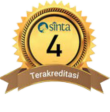Author Guidelines
AUTHOR GUIDELINES
Manuscript Template
https://drive.google.com/file/d/1CmFpB8FcyVR2i94OnPZGppRzTI-o-Ix6/view
A. General Requirements
The manuscript texts are written in English or Indonesia. Manuscripts will be first reviewed by editorial boards.The main text of a manuscript must be submitted as a Word document (.doc) or Rich Text Format (.rtf) file. The manuscript consists of 5000 words (minimum), well-typed in single column on A4 size paper, use 12 pt of Times New Roman.The manuscript contains an original work and have potentially contribute to the highly scientific advancement.
B. The manuscript should contain the following section in this order:
1. Title
Title of articles in English should describe the main content of manuscripts, be informative, concise, and not too wordy (12-15 words only), and does not contain formulas;
2. The author’s name
Full name without academic degrees and titles, written in capital letters. Manuscript written by groups needs to supplemented by complete contact details;
3. Name of affiliation for each author
The author name should be accompanied by complete affiliation address, postal code number, telephone number and email address;
4. Abstract
Written briefly in English in one paragraph of 150-200 words, containing background, research objectives, methodology, results, conclusion of the study and your research contributions to science;
5. Keywords
Written in English 3-5 words or groups of words, written alphabetically;
6. Introduction
Explaining the background, problems, importance of research, brief literature review that relates directly to research or previous findings that need to be developed, and ended with a paragraph of research purposes. A balance must be kept between the pure and applied aspects of the subject.The introduction is presented in the form of paragraphs of approximately 1000 words;
7. Methods
Make sure that work can be repeated according to the details provided. It contains technical information of the study presented clearly. Therefore, readers can conduct research based on the techniques presented. Materials and equipment specifications are necessary. Approaches or procedures of study together with data analysis methods must be presented;
8. Results and Discussion
Well-prepared tables and or figures must be of significant feature of this section, because they convey the major observations to readers. Any information provided in tables and figures should no longer be repeated in the text, but the text should focus on the importance of the principal findings of the study. In general, journal papers will contain three-seven figures and tables. Same data can not be presented in the form of tables and figures. The results of the study are discussed to address the problem formulated, objectives and research hypotheses. It is higly suggested that discussion be focused on the why and how of the research findings can happen and to extend to which the research findins can be applied to other relevant problems;
9. Conclusion
Conclusion should be withdrawn on the basis of research findings, formulated concerns and research purposes. Conclusion is presented in one paragraph without numerical form of expression. Explain your research contributions to science;
10. Acknowledgement
Contributors who are not mentioned as authors should be acknowledged, and their particular contribution should be described. All sources of funding for the work must be acknowledged, both the research funder and the grant number (if applicable) should be given for each source of funds;
11. References
The degree of sophistication of materials referred to in the last 10 years. The list of references is expected to be 80% of primary sources originating from national and international research articles. The higher the referenced primary literature, the higher the quality of the articles written with a note that the author often refers to himself (self citation) which can reduce the assessment. One of the references for writing articles as far as possible is taking from the previous article in the JASNA Journal: Journal For Aswaja Studies. Writing bibliography using APA Styles. The bibliography that is written is only what is referred to in the article and is arranged alphabetically. Authors are required to use citation tools, such as Zotero, Endnote, or Mendeley to ensure that the references and bibliography are written in accordance with the writing style in JASNA: Journal For Aswaja Studies. Writing of manuscripts and citations referred to in this manuscript. [Times New Roman, 11, spaced 1.5].
Example of in-text Citations:
Author: 1 person
Richards (2001) states ……
The curriculum in language teaching should …. (Richards, 2001).
Authors: 2 people
Taylor and Bogdan (1984) suggest …..
Qualitative research methods should…... (Taylor & Bogdan, 1984).
Authors: 3-5 people
Roe, Stoodt, and Burns (1995) suggest that ……..
In the midst of drafting a paper, peer ….. (Roe, Stoodt, & Burns, 1995).
(In the next citations will be:)
Roe et al. (1995) suggest that ……..
In the midst of drafting a paper, peer ….. (Roe et al., 1995).
Authors: 6 people more
Davies et al. (2011) state …..
A needs analysis from ........ (Davies et al., 2011).
Example of the List of References:
Adinlou, N. A., & Far, L. M. (2014). The relationship of self-efficacy beliefs, writing strategies, and the correct use of conjunctions in Iranian EFL learners. International Journal of Applied Linguistics & English Literature, 3(4), 221-227. doi:http://dx.doi.org/10.7575/aiac.ijalel.v.3n.4p.221
Davies, Y., Mishima, T., Yokomuro, S., Arima, Y., Kawahigashi, Y., Shigehara, K., … Takizawa, T. (2011). Developing health information literacy: A needs analysis from the perspective of preprofessional health students. Journal of the Medical Library Association. 100(4), 277–283. doi:10.3163/1536-5050.100.4.009
Hashemnejad, F., Zoghi, M., & Amini, D. (2014).The relationship between self-efficacy and writing performance across genders. Theory and Practice in Language Studies, 4(5), 1045-1052. doi:10.4304/tpls.4.5.1045-1052
Nashruddin, W. (2013). Why muslim students plagiarize in writing English texts? Journal on English as a Foreign Language (JEFL), 3(2), 93-103. doi:http://dx.doi.org/10.23971/jefl.v3i2.68
Richards, J. C. (2001). Curriculum development in language teaching. New York: Cambridge.
Roe, B. D., Stoodt, B. D., & Burns, P. C. (1995). Secondary school reading instruction: The content areas (5th ed.). Boston: Houghton Mifflin Company.
Taylor, S., & Bogdan, R. (1984). Introduction to qualitative research methods: The search for meanings (2nd ed.). New York: Wiley.










